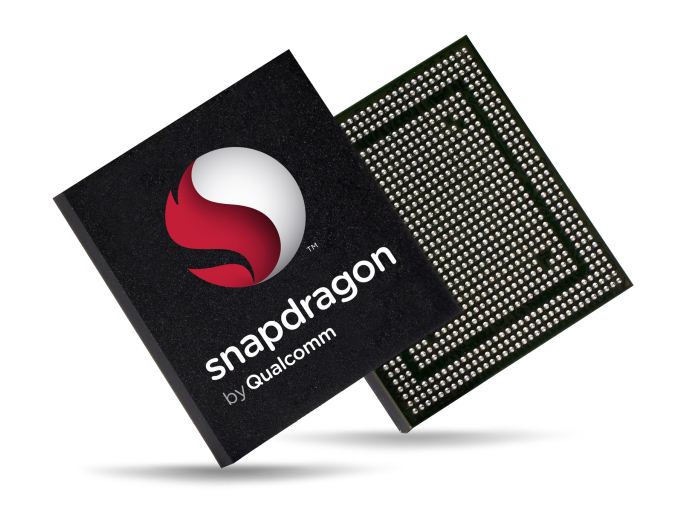Qualcomm Details Snapdragon 821: Clocks, Efficiency, and IP
by Joshua Ho on August 31, 2016 7:30 AM EST
While Qualcomm already announced the Snapdragon 821, with the announcement details were rather sparse. Fortunately, today Qualcomm followed up with more details. Those that followed the announcement might recall that the only information disclosed at the time was that the CPU big cluster was now at 2.4 GHz. Today, we also get a GPU clock disclosure, with full details as seen below.
| Snapdragon 820 | Snapdragon 821 | |
| CPU Perf Cluster | 2x Kryo 2.15 GHz | 2x Kryo 2.34 GHz |
| CPU Power Cluster | 2x Kryo 1.59 GHz | 2x Kryo 2.19 GHz |
| GPU | Adreno 530 624 MHz | Adreno 530 653 MHz |
Interestingly enough, Qualcomm is also claiming a 5% bump in power efficiency, which sounds like it’s actually referring to platform power but could just be overall SoC efficiency. Other marketing bullet points include support for Snapdragon VR SDK which allows for Daydream support as well as dual phase detection. I’m not sure what this is unless this is referring to support for two separate phase detect auto focus systems similar to the Sony Alpha SLT-A99, but Qualcomm is claiming that this will improve autofocus speed compared to a traditional PDAF solution. The ISP also now supports extended ranges for laser AF, so systems like those seen in the LG G5 and HTC 10 will be able to better guide contrast AF for devices where PDAF isn’t available or can’t be used.
Qualcomm is also citing some interesting statistics for user experience with the Snapdragon 821, such as 10% faster boot speed, 10% faster app loads, and some BSP changes combined with faster processing to enable smoother scrolling and improved web browsing performance. The Snapdragon 821 SoC is already shipping in devices like the ASUS ZenFone 3, so we shouldn’t be far off from seeing major launches using this SoC. It's interesting to note here that last year we got details of Snapdragon 820 by September but we have yet to see what Qualcomm plans to launch for next year's flagships. It'll be interesting to see whether they stay with a custom CPU core or elect to go with an ARM Cortex big.LITTLE configuration similar to the Kirin 950.










32 Comments
View All Comments
Ironchef3500 - Wednesday, August 31, 2016 - link
Any chance for this in the new nexus phones?Endda - Wednesday, August 31, 2016 - link
Rumors seem to indicate they will beGasaraki88 - Wednesday, August 31, 2016 - link
The SDs are getting too hot and power hungry. It's time for another vendor to step up to the plate and bring the heat down and performance up.MrSpadge - Wednesday, August 31, 2016 - link
Still grumpy because of the 1st version of SD810?syxbit - Wednesday, August 31, 2016 - link
I am. The SD808 and SD810 ruined most 2015 flagship devices. As is Apple needed a larger SoC lead... Assuming the 2016 Nexuses will use SD821, they should be in decent shape. Still, this is an iteration is an SoC that should have shipped last year to be competitive...zodiacfml - Thursday, September 1, 2016 - link
It will only be brought if they choose to. The 820 can be low power at the expense of lower perdormance. Apple's chips work well because they use larger die sizes to improve performance . Consider that Apple's chips are larger than Intel's Core Ms which scales from 4.5w to 15w.extide - Saturday, September 3, 2016 - link
Core m uses the exact same die as the regular COre i line dual-cores -- so the same as the i3's. I think those go up to 65w, so that's the same die from 4.5w to 65w.zeeBomb - Wednesday, August 31, 2016 - link
New Nexuses and the V20? But I hope this a good follow-up to the 801.Notmyusualid - Wednesday, August 31, 2016 - link
Open Question:Shoot me if I'm wrong, but doesn't Intel have the most advanced FinFET tech known to man?
And if so, why have their mobile efforts largly been in vain?
PS: A friend did have an Asus (Acer?) large phone a year or so ago with an Intel Atom, and it seemed fine to me, even if the device did seem pretty 'mid-range'.
Gordonium - Thursday, September 1, 2016 - link
I think they do.Their chips were fine just that x86 really having issues with Android, that's probably why Intel is getting a license from ARM for ARM chip manufacturering.
And it's Asus.